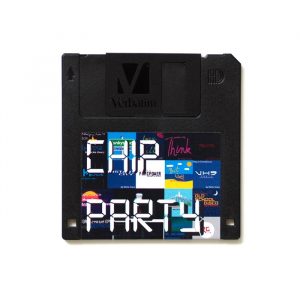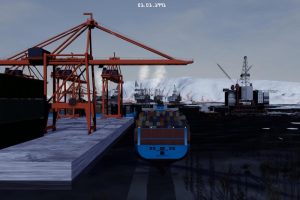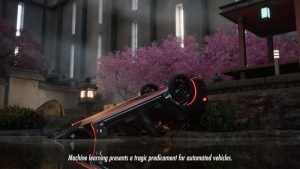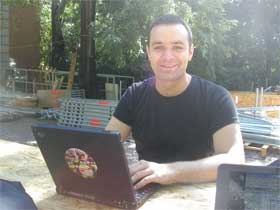 If you’re a regular reader of the blog you might be familiar with the work of Adam Somlai-Fischer and his studio Aether Architecture as i’ve maniacally blogged most of their projects.
If you’re a regular reader of the blog you might be familiar with the work of Adam Somlai-Fischer and his studio Aether Architecture as i’ve maniacally blogged most of their projects.
Aether architecture develops interactive installations such as the BrainMirror, that mixes the image of your brain with your mirror image; works on research projects like Low Tech Sensors and Actuators (developed together with Usman Haque) that investigates how low-tech sensors and interactive actuators can be produced inexpensively from hacked toys and devices; and explores the thresholds between architecture and media with the Aether Induction House prototypes.
More recently, the group has been presenting Ping Genius Loci in several countries. The installation is made of 300 radio networked, solar powered, self sustainable analogue pixels, placed on a 20 by 20 meters grid. These pixels are interfacing the people walking in the grid. It also can act as a large low resolution screen as each device individually switches its RGB like configurations.
Last week, Adam, Usman Haque and Bengt Sjölén unveiled at the Wave festival in Riga the Wifi Camera Obscura, a system that takes photographs of the wifi space.
Adam is currently busy co-coordinating Reorient – migrating architectures, the Hungarian project to the architecture biennale in Venice. The project involves laying cat bricks, wiring little penguins, hanging cars on the walls, composing a moving sound collage, creating an ultrasonic garden… The work is looking into the local aspects of China’s global significance and increasing influence. The final installation will re-appropriate cheap and ubiquitous technologies to present an alternative contemporary architectural experience built from thousands of functioning networked Chinese toys.
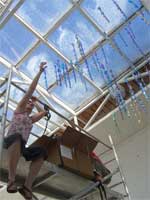
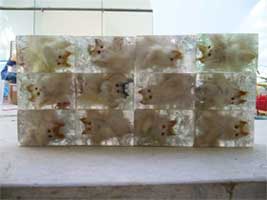 Building the Hungary Pavilion and Cat Bricks
Building the Hungary Pavilion and Cat Bricks
What is your background? How did you start aether architecture?
During the last years of my architecture studies we started making flash websites, with a architectural agenda. We were fascinated, that the way people talk about the web is so much location, place -like, but its appearance was dominated by magazine-like graphic design aesthetics. We tried to translate concepts like atmosphere or adaptive spaces into flash websites. We actually formed aether (first called lowcat) around this, with Peter Hudini and Anita Pozna, while making sites like the mirallestagliabue.com.
More or less following up from here, my diploma project departed from the sadness of this computer beauty; its easy to create seductive content, but its hard to make it multi sensual, there is an embedded distancing in this medium. The 1 cm thick glass of a CRT screen, is actually quite metaphorical, were you can never touch the pixels, its a very tangible boundary.
So I got focused on issues, that involve mediated spaces, HCI, programmable phenomena, all related to people and technology in social and private settings. One thing emerged here that had a strong impact on the way I work today, the diploma consisted of a set of installation, that I realized in collaboration with others at various platforms, in a shared setup, but with having my personal agenda in there all the way.
Today i have the pleasure to work mostly with Anita Pozna and Bengt Sjölén, and collaborate with a set of great people like Usman Haque and Andras Kangyal on various smaller projects.
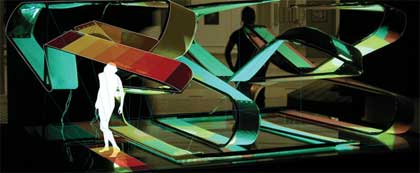 Prototype of Aether Induction House
Prototype of Aether Induction House
Our increasingly technology-mediated environment is giving way to new models of architecture. What do you think are the challenges of these new breeds of architecture? Do you feel that the whole architecture field has understood what s going on or is there still some resistance to it and sticking to old forms of architecture?
I think the elite design offices are more conventional, mostly stuck on form. But luckily making architecture is a social process, its not a single author medium. The potential lies within the people who would use such spaces, as the social space is already there; have a look at these teenagers living social life.
One of the main obstacles of course is that you also need to develop new skills. The medium of architecture is changing, so the medium of the architect has to change as well. If the experience and functions that you are creating are all new, its impossible to communicate them on illustrations, drawings. Form-focused architecture can do that, but technologically livings systems can not. You have to make these things for real before you can sell them to people. In some disciplines prototyping has been common, but not in architecture. And of course moving from the ruler to the soldering iron is a strange step to take.
What’s the impetus of your research on low tech solutions?
There are several reasons. Following on the above, invention in architecture can not rely on expensive and inaccessible technologies. We do have massive amounts of available ubiquitous intelligence lying around without being utilized. Also in general, the thinking culture of opening and re-appropriating available technologies is very interesting I think. It also has to do with technological literacy, and your own personal freedom to express yourself and change your social and private spaces.
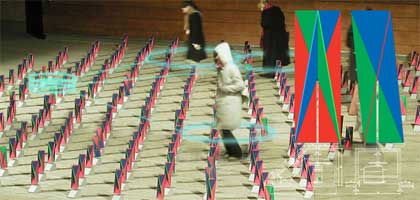 Ping Genius Loci
Ping Genius Loci
You put the development process of your work online, onto the “Open Design Archives”. Which kind of feedback have you received so far? Has it been useful? What would you say to architects or designers who are afraid of making such open move?
Well we did get some help, tough not that much. But one of the greatest thing about open source projects, is that the code / technology / process is available, and will stay available in the future, so people running into related issues can use our results. Most FLOSS projects are small, and build upon each other. I think this is the space we are aiming for, definitely not to make the Linux of architecture.
As I am mostly interested in the cultural values in these experiments, I have not put much effort on commercializing anything, no patents, no agreements of secrecy. In the knowledge society, I get paid for what I know, and not for what I own. I enjoy this, as it hopefully leads to knowledge accumulation, and not just capital accumulation :)
How do you finance your experiments? Do you rely on grants? Commercial commissions?
Both, and some academic research as well. These are the 3 major contexts, cultural funds, academic research and commercial commissions, and i think i gain from all of them.
Is Hungary a fertile ground for the kind of interactive space you re working on? How s the scene over there?
The scene is tiny. I rely on cheap flights and lots of online socializing.
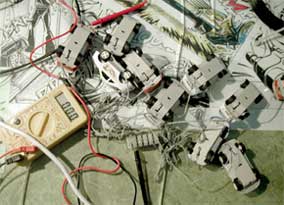
 Wired cars and walkie talkies for the Radio arbour
Wired cars and walkie talkies for the Radio arbour
The Hungarian Pavilion you re working on for the architecture Biennale in Venice seems to be quite unconventional. Can you tell us a few words about it? Why did you chose to focus on “China’s global significance and increasing influence”?
Just to make it absolutely clear (again), its a team work, with about 10 other people, and my main role is the coordination of the installation, but its a fairly flat setup.
About the subject, well I think its very common to look at China today, for good reasons. It has obviously taken over production in general, and its taking over invention and design as well as we talk. The bluff of high profile brands selling Chinese products after relabeling for immense profit will not last very long. Living with this, on the consumer end of this process, we should really build up an understanding. So the project is not about China really, it’s about what China means here, in any European city.
If I would sum up the experiment, it’s attaching lasting cultural values to cheap products, and using these to make a new kind of architecture, that is possibly more relevant for the contemporary sociality than form-focused architecture. Its aesthetic experience lies in the sweet not in the cool, but most definitely in the aesthetics of systems. But it’s all really simple, and open for people to reuse, to depart from.
Can you detail some of the installations in the pavilion, like radio arbour and ultrasonic garden?
The radio arbour is made from 1000 tiny penguin shaped walkie talkies hanging from garden hangers, creating radio and audio interferences, just next to the ultrasonic garden, that has about a hundred plastic bowls of water and fern mixed with ultrasonic water evaporators, creating a self sustaining garden where you water the technology rather then the plants.
I have to say though, that to be able to navigate in this new kind of space, we gave names to various parts, but they don’t stand as separate art objects. Most are somewhat improvised, changing as we speak, we build up and take lots of skills together and shape things as they grow.
 LED lillies
LED lillies
Unlike what one would expect for an architecture biennale, you haven t worked following the usual scenario involving a curator and an architecture studio. Instead, you’ve been collaborating with social scientists, media researchers and anthropologists. Are you familiar with this interdisciplinary method? Is it an easy task to work with people from such different fields and speaking different language? Do you think that it is the way to do architecture today? Why? Because our world is increasingly complex?
Yes, absolutely. We do need to be informed by the understanding of other thinking cultures about issues related to social space, identity, and so on. So the best way to go was to set up a tight team of great innovative people, from different disciplines, and share the whole process. This way most do put in tremendous amounts of energy as the project really belongs to all of us.
But I am trying to work this way since some time. I have a part time guest researcher position at the department of social sciences, at the technical university in Budapest. Here i do get a lot of information I would not get otherwise, and I am hoping I can return some about the things I focus on. We all enjoy learning, that’s one main motive.
How do you expect the public to react to the pavilion? will it be a very intuitive experience or does it require lovely hostesses giving explanations about the way to interact or handing leaflets explaining how it works?
No explanations, no metaphorical works. We expect this space to be love-able, desirable, and than next step is make-able, DIY-able, so that people don’t run to us, could you make a (put your favorite thing here) but go to the website, and download the PCB layout or whatever they need to make something. Though I have to admit this is an experiment, so the above is what we are hoping for :)
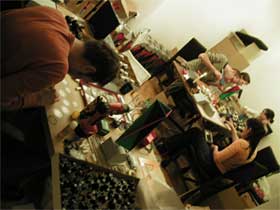 You are awfully young and successful. Do you have tips for would-be interaction designer/architect who would like to explore the same field as you?
You are awfully young and successful. Do you have tips for would-be interaction designer/architect who would like to explore the same field as you?
You are very kind, thank you, well this is really relative, I don’t feel it’s that bad, I hope I am still at the beginning :)
But if any, the advice is collaboration, group work, I owe most to all the fantastic people i had the pleasure to work with. And I think what is really crucial is to have a real life motivation, not the motivation of copying others or getting published. You do get attention only if you are working on something that is relevant in some context.
Any artist or architect from Hungary whom you think should get more attention from the public?
Nextlab. It’s a small open community, an independent media lab from Budapest, with a set of great people like Tamas Szakal (remember float from isea2004) or Andras Kangyal, and many others. (site members page is not very up to date)
Thanks Adam!
See Re:orient at the 10th International Architecture Exhibition which will run from September 10 to November 19, 2006 in Venice, Italy. Have your bluetooth on during your visit to the pavilion, as the Hungarian team will be pushing project goodies to your mobile phone!

